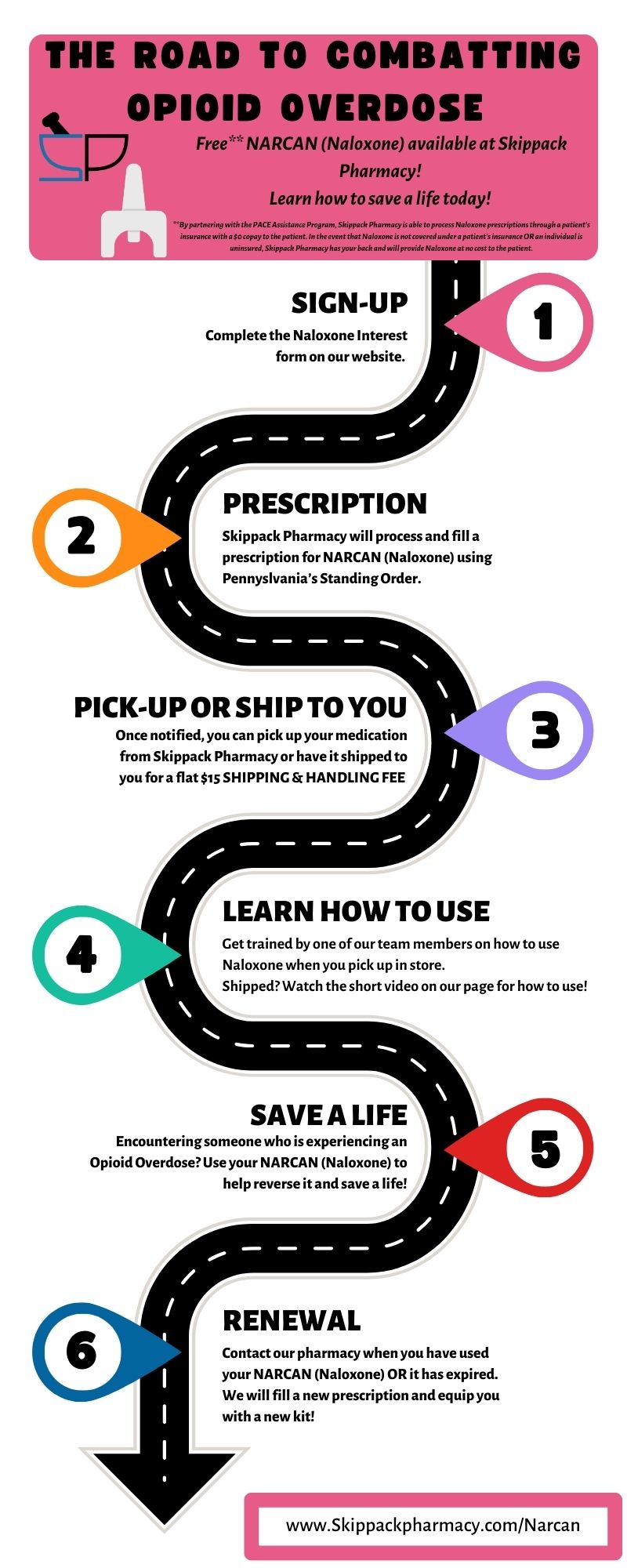Looking To Become A Superhero Within Your Community?
FREE** NARCAN (Naloxone) Nasal Spray For Reversal of Opioid Overdose!
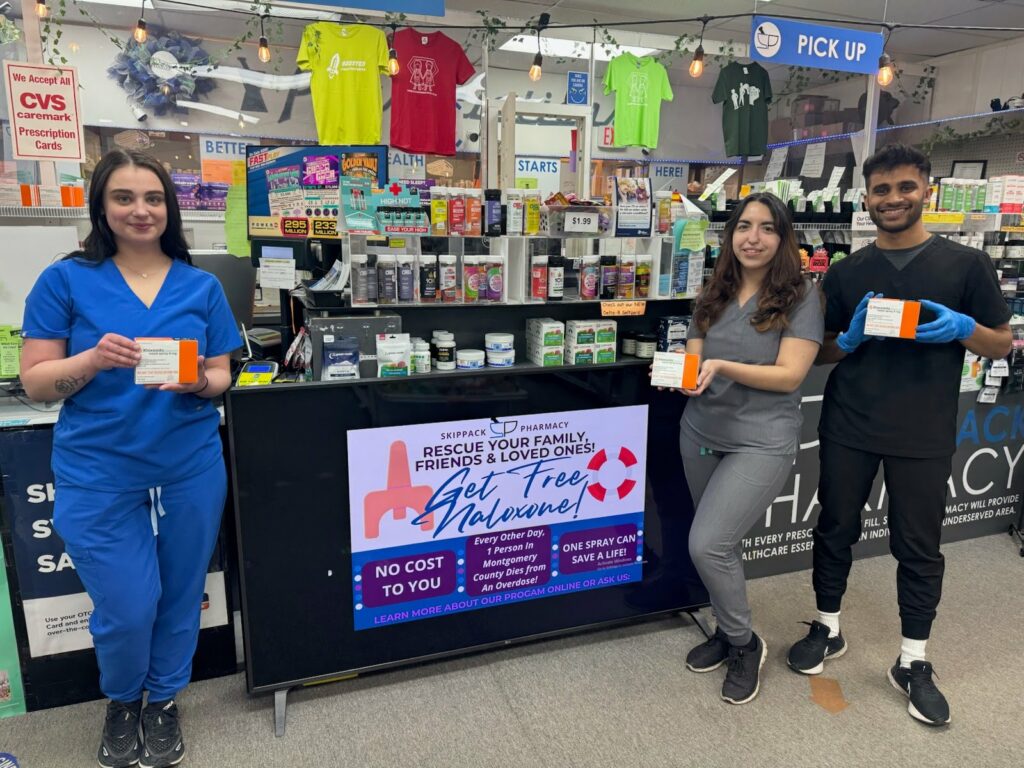
**By partnering with the PACE Assistance Program, Skippack Pharmacy is able to process Naloxone prescriptions through a patient’s insurance with a $0 copay to the patient. In the event that Naloxone is not covered under a patient’s insurance OR an individual is uninsured, Skippack Pharmacy has your back and will provide Naloxone at no cost to the patient.
NARCAN (Naloxone) is a life-saving medication that can be used to quickly reverse the effects of an opioid overdose. In the midst of the Opioid Epidemic, it’s important that we know how to rescue one another in the event of an emergency.
Skippack Pharmacy is proud to offer FREE NARCAN (NALOXONE) for our community! We are committed to creating a more safe and medication-educated Montgomery County!
Learn how you can SAVE A LIFE today!
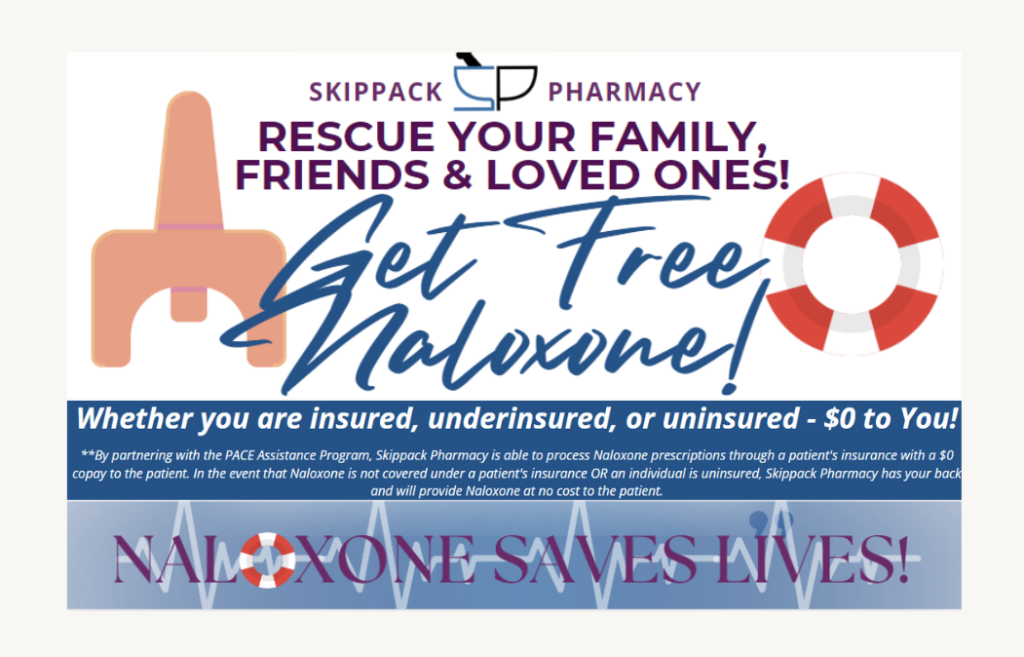
FIVE EASY STEPS TO SAVING A LIFE!
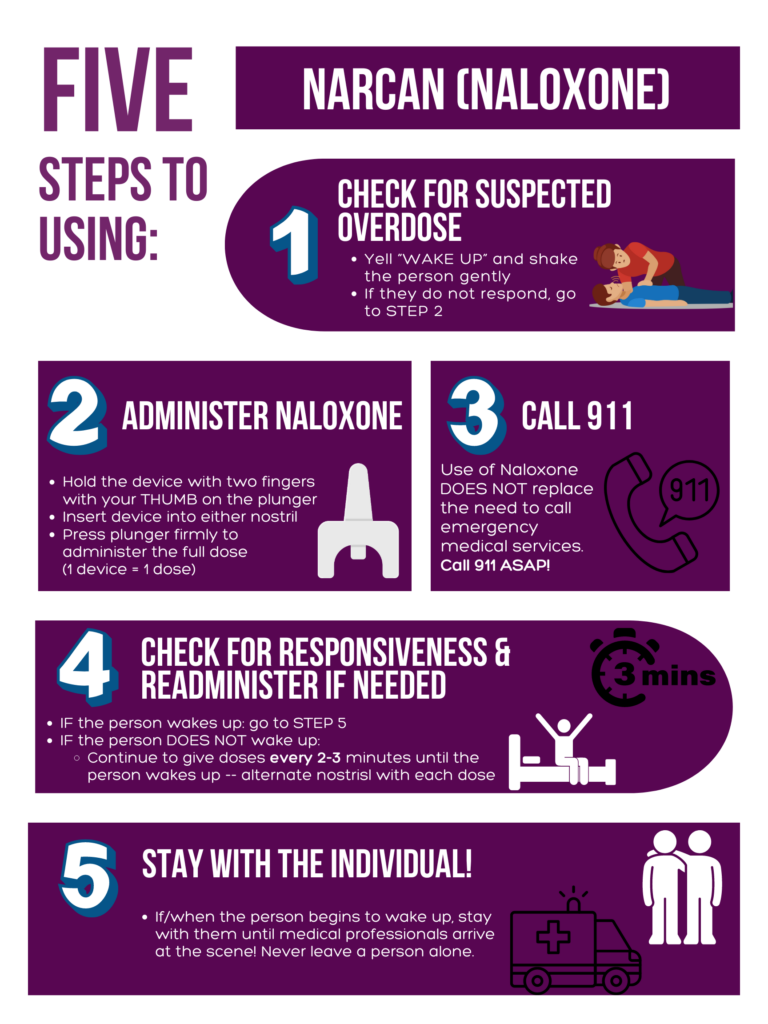
HOW TO RECOGNIZE AN OPIOID OVERDOSE
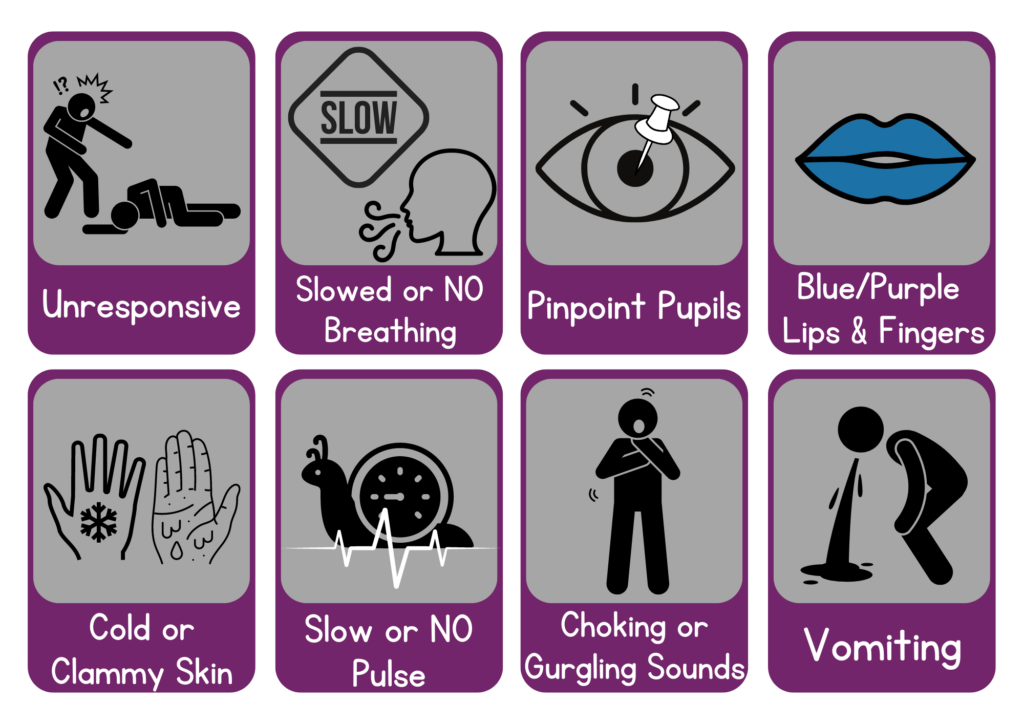
Frequently Asked Questions (FAQs)
WHY SHOULD I CARE?
I don't take opioid medications, so why is NARCAN (Naloxone) important?
- Having NARCAN (Naloxone) is important because ANYONE can be at risk of opioid overdose for multiple reasons, including use of prescription medications, accidental ingestion, and other factors.
- NARCAN (Naloxone) is a vital emergency supply, such as first aid kits, epipens, and defibrillators. Remember that we are not judging those who may use opioid medications – we are here to emphasize the importance of being prepared for emergencies and knowing how to save a life
USAGE & ADMINISTRATION
What is NARCAN (Naloxone) Nasal Spray?
Naloxone nasal spray is an intranasal (through the nose) medication that is designed to rapidly reverse the effects of an opioid (narcotic medication) overdose, which is a life-threatening situation. It is used to revive an individual who has overdosed from the use of commonly prescribed pain medications and/or commonly seen “street drugs” (i.e., heroin, fentanyl).
Who should have NARCAN (Naloxone) on hand?
Everyone should have access to and carry NARCAN (Naloxone) on hand with them, even if they do not use opioids or street drugs. It is encouraged that every individual carries Naloxone with them (or at least leaves it in the car) because you never know when you may encounter someone that is experiencing an opioid overdose. Family members and friends of known opioid-users should have Naloxone on-hand; parents and guardians of teenagers and/or college-students should have Naloxone on hand; every bystander should have Naloxone on hand.
How does NARCAN (Naloxone) work?
Naloxone, the active ingredient in NARCAN, is an opioid antagonist, meaning that it competes for the same receptors in the brain that opioid medications and drugs bind to. When administered, NARCAN (Naloxone) can reverse the effects of an opioid overdose within 2-3 minutes, creating additional time for medical emergency services to arrive on site.
How do I administer NARCAN (Naloxone)?
You can go to this link to watch a tutorial video on how to use NARCAN (Naloxone) Nasal Spray
As per the instructions provided, NARCAN (Naloxone) is administered in five (5) steps:
- STEP 1
-
- Check for suspected overdose (unconscious, excessive sleepiness, not breathing well)
- Yell “WAKE UP” & shake the person gently
- If the individual does not respond/wake, go to STEP 2
-
- STEP 2
-
- HOLD the nasal spray device between two fingers with your THUMB on the bottom of the plunger
- INSERT the nozzle into either nostril
- PRESS the plunger firmly to administer the full dose (1 nasal spray device = 1 dose)
-
- STEP 3
-
- CALL 911 immediately after administering the 1st dose
-
- STEP 4
-
- WAIT 2-3 minutes after the first dose to give the medication time to work
- IF the person wakes up: go to STEP 5
- IF the person DOES NOT wake up:
- Continue to give doses every 2-3 minutes until the person wakes up or medical services arrive
- NOTE: it is safe to keep re-administering doses
-
- STEP 5
-
- Once the individual has woken up, place them in recovery position (pictured below)
- Remain on site until the ambulance arrives, EVEN IF the person has woken up
- Once the individual has woken up, place them in recovery position (pictured below)
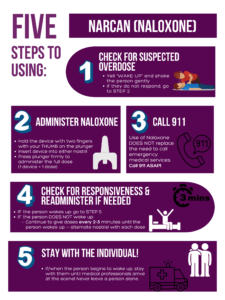
-
Can I use NARCAN (Naloxone) on myself?
No, NARCAN (Naloxone) CANNOT be self-administered as it is used to revive individuals currently experiencing an overdose (i.e., non-responsive). If you are taking prescription opioid medications and/or using non-prescription opioids, alert your friends and family where you keep your NARCAN (Naloxone) and teach them how to use the nasal spray in the event of an emergency
Does NARCAN (Naloxone) replace calling emergency services (ex. 911)?
NO! Use of NARCAN (Naloxone) is the first step in reversing an opioid overdose, but DOES NOT replace the need to seek medication attention. If you or someone you know is experiencing an overdose, call 911 immediately.
How do I store NARCAN (Naloxone) nasal spray?
- NARCAN (Naloxone) should be stored at room temperature 36-77 F
- DO NOT FREEZE
- Avoid exposure to excessive heat above 104 F
- Protect this medication from light
- NARCAN (Naloxone) may be kept in cars, purses, houses, or anywhere else where you might need it in the event of an overdose emergency
Can I use NARCAN (Naloxone) in the same nostirl more than once?
Yes, you can use it in the same nostril more than once. However, it is recommended that you alternate nostrils with each dose.
Is NARCAN (Naloxone) reusable?
- No, each nasal spray device is SINGLE-USE. Each device is a complete dose of Naloxone. Multiple devices (doses) may be necessary to reverse the overdose.
IMPACT & SIDE EFFECTS
Can you overdose on NARCAN (Naloxone)?
No. Naloxone is an opioid-antagonist and therefore does not have the same overdosing effects as opioid medications. It is safe (and recommended) to continuously administer doses every 2-3 minutes until the individual wakes up again.
How many times can I use NARCAN (Naloxone)?
Naloxone can be administered multiple times if necessary, depending on the patient’s response to the drug and the severity of the opioid overdose. Here are some key points about using naloxone:
-
- Initial Dose: The typical initial dose of naloxone for an opioid overdose is 0.4 to 2 mg administered intravenously, intramuscularly, subcutaneously, or intranasally.
- Repeated Doses: If the initial dose does not produce the desired response (i.e., restoring normal respiration and consciousness), additional doses can be administered every 2 to 3 minutes.
- Total Dosage: There is no absolute limit to the total number of doses or total amount of naloxone that can be given, but medical professionals will typically titrate doses based on the patient’s response and the specific circumstances of the overdose.
- Duration of Action: Naloxone has a shorter duration of action compared to many opioids. This means that even if the initial administration successfully reverses the overdose, the effects of the opioid may outlast those of naloxone. Repeated doses or a continuous infusion may be necessary to maintain the reversal effect.
What are the common side effects from using NARCAN (Naloxone)?
NARCAN (Naloxone) is generally safe, especially when used in emergency situations to reverse opioid overdoses. However, it can cause some side effects, including withdrawal symptoms.
- Common Side Effects
-
- Withdrawal Symptoms: In individuals dependent on opioids, naloxone can precipitate withdrawal symptoms. These can include:
- Body aches, Diarrhea, Increased heart rate (tachycardia), Fever, Runny nose, Sneezing, Goosebumps (piloerection), Sweating, Yawning, Nausea or vomiting, Nervousness or restlessness, Irritability. Shivering or trembling, Abdominal cramps, Increased blood pressure
-
- Considerations
-
- Pain: Naloxone can reverse the analgesic effects of opioids, potentially causing significant pain if the person was using opioids for pain relief
- Overdose Risk: If naloxone is administered in a situation where opioids are present in the system in high amounts, there may be a risk of re-overdose after the naloxone wears off.
-
- Emergency Use
-
- In an emergency, the benefits of using naloxone to reverse a potentially fatal opioid overdose far outweigh the risks of side effects. It is crucial to seek immediate medical assistance after administering naloxone, as the person may need further medical care.
-
How long will NARCAN (Naloxone) stay in my system?
Onset and Duration of Action
-
- Onset: Naloxone typically begins to work within 2 to 5 minutes of administration.
- Duration: The effects of naloxone last for about 30 to 90 minutes.
OPIOID EDUCATION
What are opioids?
Opioids are a class of drugs that act on the nervous system to produce pain-relieving and euphoric effects. They are derived from the opium poppy plant or are synthetically made. Opioids are commonly used for their analgesic (pain-relieving) properties but can also be highly addictive and have a potential for abuse.
How do opioids work?
Opioids bind to specific receptors in the brain, spinal cord, and other parts of the body called opioid receptors. By binding to these receptors, they block the transmission of pain signals and release large amounts of dopamine, creating a sense of euphoria.
What are the different types (classes) of opioids?
- Natural Opioids: Derived directly from the opium poppy
-
- Examples: Morphine, Codeine
-
- Semi-Synthetic Opioids: Created from natural opioids
-
- Examples: Heroin (diacetylmorphine), Oxycodone, Hydrocodone, Hydromorphone
-
- Synthetic Opioids: Completely man-made.
-
- Examples: Fentanyl, Methadone, Tramadol, Buprenorphine
-
What are opioids used for?
- Pain Relief: To manage moderate to severe pain.
- Cough Suppression: Certain opioids (e.g., codeine) are used in cough syrups.
- Anesthesia: Used during surgery to induce and maintain anesthesia.
- Diarrhea Treatment: Some opioids can treat severe diarrhea (e.g., loperamide).
What opioids are commonly seen?
- Prescription Opioids: Oxycodone (OxyContin), Hydrocodone (Vicodin), Morphine, Methadone, Fentanyl.
- Non-prescription (Illegal) Opioids: Heroin, illegally manufactured fentanyl.
Is Cocaine an Opioid?
No, cocaine is not an opioid. Cocaine is a powerful stimulant drug, derived from the coca plant, that increases levels of dopamine in the brain, leading to heightened alertness, energy, and feelings of euphoria.
Therefore, NARCAN (Naloxone) WILL NOT WORK if an individual is experiencing an overdose from cocaine use.
OPIOID OVERDOSE
What is an opioid overdose?
An opioid overdose occurs when a person consumes an amount of opioids that is too high for their body to handle, leading to potentially life-threatening symptoms. This can depress the body’s central nervous system, leading to respiratory failure and other severe complications. Recognizing the signs and symptoms of an opioid overdose can be critical for timely intervention and can save lives.
What are the causes of an opioid overdose?
- Taking a higher dose than prescribed or recommended
- Using opioids in combination with other depressants, like alcohol or benzodiazepines
- Using opioids with higher potency (e.g., fentanyl)
- Relapse after a period of abstinence, where tolerance has decreased
- Using opioids without medical supervision
What are the signs/symptoms of an opioid overdose?
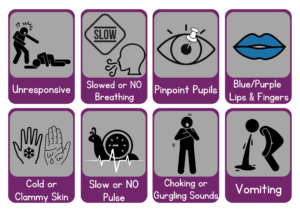
- Respiratory Depression
-
- Slow, shallow, or irregular breathing (or no breathing at all)
- Gasping for air or choking sounds
- Cyanosis (bluish tint) of the lips or fingernails due to lack of oxygen
-
- Extreme Drowsiness or Unresponsiveness
-
- Inability to wake up or respond to voice or touch
- Unconsciousness
-
- Pinpoint Pupils
-
- Constricted, tiny pupils (miosis), although in severe cases, they can be dilated due to hypoxia (lack of oxygen)
-
- Weak Pulse
-
- Slow or erratic heartbeat
- Low blood pressure
-
- Skin Changes
-
- Pale, clammy skin
- Blue or purplish skin color, particularly around the lips and fingernails
-
PRESCRIPTION NARCAN (NALOXONE) INFORMATION
Where can I find the prescribing information for NARCAN (Naloxone)
- The prescribing information can be found by clicking here
Are there any contraindications to using NARCAN (Naloxone)?
No. NARCAN (Naloxone) is a life-saving medication that can be used to reverse an opioid overdose, therefore the benefits outweigh any risks of use. The only contraindication for use is a known allergy to naloxone hydrochloride.

